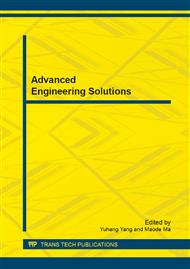[1]
Mohammed S. EI-Abbasy, Tarek Zayed, M. ASCE, Marwa Ahmed, Hani Alzraiee, Mona Abouhamad, 2013. Contractor selection model for highway projects using integrated simulation and Analytic Network Process. Journal of Construction Engineering and Management, 139, 755-767.
DOI: 10.1061/(asce)co.1943-7862.0000647
Google Scholar
[2]
Jeffrey K. Pinto, Dennis P. Slevin, Brent English, 2009. Trust in projects: An empirical assessment of owner/contractor relationships. International Journal of Project Management, 27(2009), 638-648.
DOI: 10.1016/j.ijproman.2008.09.010
Google Scholar
[3]
Ramy Zaghloul, Francis Hartman, 2003. Construction contracts: the cost of mistrust. International Journal of Project Management 21 (2003) , 419-424.
DOI: 10.1016/s0263-7863(02)00082-0
Google Scholar
[4]
Edkins, A.J., Smyth, H.J., 2006. Contractual management in PPP projects: evaluation of legal versus relational contracting for service delivery. ASCE Journal of Professional Issues in Engineering Education and Practice 132 (1), 82–93.
DOI: 10.1061/(asce)1052-3928(2006)132:1(82)
Google Scholar
[5]
Hatush, Z., and Skitmore, M., 1997. Quality based prequalification of contractors. J. Transp. Res. Board, 1813(0361-1981), 260-274.
Google Scholar
[6]
Holt, G., Olomolaiye, P. and Harris, F., 1995. A review of contractor selection practices in the U.K. construction industry. Build Environment, 30(4), 533-561.
DOI: 10.1016/0360-1323(95)00008-t
Google Scholar
[7]
Nurei, A., and Watada, J., 2011. Muilti-attribute decision making in contractor selection under hybrid uncertainty. J. Adv. Comput. Intell. Intell. Inf., 15(4), 465-472.
DOI: 10.20965/jaciii.2011.p0465
Google Scholar
[8]
Rosseau DM, Sitkin B, Burt RS, Camerer C, 1998. Not so different after all: a cross-discipline view of trust. Academy of Management Review, 23(3), 393–404.
DOI: 10.5465/amr.1998.926617
Google Scholar
[9]
Lewicki RJ, Bunker BB, 1996. Developing and maintaining trust in work relationships. In: Kramer RM, Tyler TR, editors. Trust in organizations: frontiers of theory and research. Sage Publications; 1996. pp.114-39.
DOI: 10.4135/9781452243610.n7
Google Scholar
[10]
Cheung, S.O., 2007. Trust in Co-operative Contracting in Construction. City University of Hong Kong Press, Hong Kong.
Google Scholar
[11]
Black C, Akintoye A, Fitzgerald E, 2000. An analysis of success factors and benefits of partnering in construction. Int J Project Manage, 18(6), 423–34.
DOI: 10.1016/s0263-7863(99)00046-0
Google Scholar
[12]
Sai On Cheung, Tak Wing Yiu and Man Chung Lam, 2013. Interweaving Trust and Communication with Project Performance Journal of construction engineering and management, 941-950.
DOI: 10.1061/(asce)co.1943-7862.0000681
Google Scholar
[13]
Photis M. Panayides, Y.H. Venus Lun, 2009. The impact of trust on innovativeness and supply chain performance. Int. J. Production Economics, 35-46.
DOI: 10.1016/j.ijpe.2008.12.025
Google Scholar
[14]
Russell, J. S., and Skibniewski, M. J., 1990. QUALIFIER-1 contractor prequalification model. J. Comput. Civ. Eng., 4(1), 77-90.
DOI: 10.1061/(asce)0887-3801(1990)4:1(77)
Google Scholar
[15]
Holt, G. D., 1996. Applying cluster analysis to construction contractor classification. Build. Environ., 31(6), 557-568.
DOI: 10.1016/0360-1323(96)00028-5
Google Scholar
[16]
Topcu, Y. I., 2004. A decision model proposal for construction contractor selection in Turkey. Build. Environ., 39(4), 469–481.
DOI: 10.1016/j.buildenv.2003.09.009
Google Scholar
[17]
McCabe, B., Tran, V., and Ramani, J., 2005. Construction prequalification using data envelopment analysis. Can. J. Civ. Eng., 32(1), 183–193.
DOI: 10.1139/l04-073
Google Scholar
[18]
Singh, D., and Tiong, R. L. K., 2005. A fuzzy decision framework for contractor selection. J. Constr. Eng. Manage., 131(1), 62–70.
DOI: 10.1061/(asce)0733-9364(2005)131:1(62)
Google Scholar


